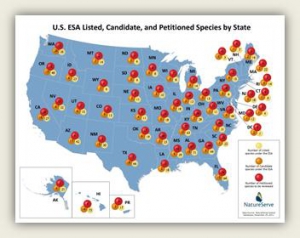On December 17, 2012, the National Association of Home Builders (“NAHB”), Olympia Mater Builders, Home Builders of Greater Austin and Texas Salamander Coalition filed suit in federal district court against the Secretary of the Interior Ken Salazar and the U.S. Fish and Wildlife Service. The plaintiffs allege the federal government has violated the Endangered Species Act (“ESA”) by failing “…to follow mandatory procedures with regard to the process for responding to petitions to list species as endangered or threatened.”
The ESA dictates that any interested person may petition the Secretary to add a species, or remove a species from, the endangered or threatened species list. If a petition is determined to present substantial information indicating a listing may be warranted, the Secretary has 12-months from the date the petition was received to decide if a listing is (1) “warranted” for listing, (2) “not warranted” for listing, or (3) “warranted, but precluded” from listing because other species have a higher priority. Species tagged “warranted but precluded” are called candidate species and are automatically recycled back through the 12-month process indefinitely until a result of either “not warranted” or “warranted” is made. A listing priority or ranking number is assigned to each candidate species to assist the Secretary in identifying which species should receive priority review for listing.
On September 9, 2011, the U.S. District Court for the District of Columbia approved two separate Settlement Agreements between the Department of the Interior (“DOI”) and environmental advocacy groups Center for Biological Diversity and Wildearth Guardians. The Agreements commit DOI to a rigid schedule (a “work plan”) which details the time and order of listing decisions for 251 candidate species. By predetermining the time and order of listing home builders believe DOI has abandoned the ranking number system mandated by the ESA. DOI has further agreed that it will not make a “warranted but precluded” finding on any of the 251 candidate species covered in the Agreement. For these species, the agency has limited itself to considering only whether a listing is (1) “warranted” or (2) “not warranted.” Home builders argue in their complaint that DOI has a non-discretionary duty to consider three choices with regard to a listing decision. Contracting away the “warranted but precluded” choice is a procedural violation of the ESA.
In years past DOI has extended ESA protections to an average of 26 species per year, with many years passing without DOI listing a single species. The settlement agreements commit DOI to the ambitious, yet realistically unattainable goal, of reviewing 251 candidate species and making final listing decisions on each of these species by September 30, 2016. (see map above and attached). A high probability exists that many of these species will be listed, and their critical habitat designed, given that the prior finding was that the listing was warranted but precluded by higher priorities. It remains unclear how an agency currently overwhelmed with new listing petitions and facing significant human and financial resource constraints will meet its obligations under the agreements.

